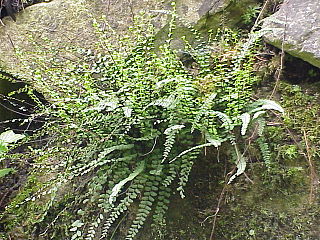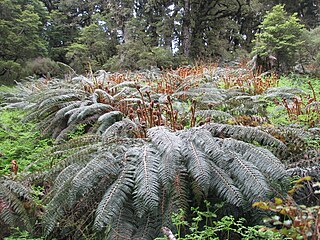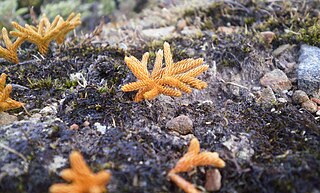
The genus Bowenia includes two living and two fossil species of cycads in the family Stangeriaceae, sometimes placed in their own family Boweniaceae. They are entirely restricted to Australia. The two living species occur in Queensland. B. spectabilis grows in warm, wet, tropical rainforests, on protected slopes and near streams, primarily in the lowlands of the Wet Tropics Bioregion. However, it has a local form with serrate pinna margins that grows in rainforest, Acacia-dominated transition forest, and also Casuarina-dominated sclerophyll forest on the Atherton Tableland, where it is subject to periodic bushfire. B. serrulata grows in sclerophyll forest and transition forest close to the Tropic of Capricorn.

Royal Botanic Gardens Victoria are botanic gardens across two sites–Melbourne and Cranbourne.

The Zamiaceae are a family of cycads that are superficially palm or fern-like. They are divided into two subfamilies with eight genera and about 150 species in the tropical and subtropical regions of Africa, Australia and North and South America.

The Daintree Rainforest is a region on the northeast coast of Queensland, Australia, north of Mossman and Cairns. At around 1,200 square kilometres (460 sq mi), the Daintree is a part of the largest continuous area of tropical rainforest on the Australian continent. The Daintree Rainforest is a part of the Wet Tropics of Queensland Rainforest, that spans across the Cairns Region. The Wet Tropics Rainforest is the oldest continually surviving tropical rainforest in the world. Along the coastline north of the Daintree River, tropical forest grows right down to the edge of the sea.

Blandfordia, commonly known as Christmas bells, is a genus of four species of flowering plants native to eastern Australia. Christmas bells are tufted, perennial herbs with narrow, linear leaves and up to twenty large, drooping, cylindrical or bell-shaped flowers.

Osmundastrum is genus of leptosporangiate ferns in the family Osmundaceae with one living species, Osmundastrum cinnamomeum, the cinnamon fern. It is native to the Americas and eastern Asia, growing in swamps, bogs and moist woodlands.

Bowenia serrulata, the Byfield fern, is a cycad in the family Stangeriaceae. Its bipinnate fronds, arising from a subterranean caudex, give it the appearance of a fern. However it is not a fern as its vernacular name and appearance suggest. It is endemic to the vicinity of Byfield, Australia.

Woolwich Dock is a former dry dock and shipyard in Woolwich, Sydney, New South Wales, Australia. The site was purchased by Morts Dock and Engineering Company in 1898. When it was officially opened on 4 December 1901 it was the biggest dry dock in Australia, at 188 metres (617 ft) long and 27 metres (89 ft) wide.

Asplenium trichomanes, the maidenhair spleenwort, is a small fern in the spleenwort genus Asplenium. It is a widespread and common species, occurring almost worldwide in a variety of rocky habitats. It is a variable fern with several subspecies.

The flora of Australia comprises a vast assemblage of plant species estimated to over 30,000 vascular and 14,000 non-vascular plants, 250,000 species of fungi and over 3,000 lichens. The flora has strong affinities with the flora of Gondwana, and below the family level has a highly endemic angiosperm flora whose diversity was shaped by the effects of continental drift and climate change since the Cretaceous. Prominent features of the Australian flora are adaptations to aridity and fire which include scleromorphy and serotiny. These adaptations are common in species from the large and well-known families Proteaceae (Banksia), Myrtaceae, and Fabaceae.

Angiopteris evecta, commonly known as the king fern, giant fern, elephant fern, oriental vessel fern, Madagascar tree fern, or mule's Foot fern, is a very large rainforest fern in the family Marattiaceae native to most parts of Southeast Asia and Oceania. It has a history dating back about 300 million years, and is believed to have the longest fronds of any fern in the world.

Polystichum vestitum, commonly known as the prickly shield fern or pūnui (Maori), is a hardy, evergreen or semi-evergreen ground fern.

Pittosporum bicolor, commonly known as cheesewood or banyalla, is a flowering shrub or small tree of the family Pittosporaceae, and is native to south eastern Australia.

Austrolycopodium fastigiatum, synonym Lycopodium fastigiatum, commonly known as alpine club moss or mountain club moss, is a species of club moss native to New Zealand and Australia. The genus Austrolycopodium is accepted in the Pteridophyte Phylogeny Group classification of 2016, but not in other classifications which submerge the genus in Lycopodium.

Diphasium scariosum, synonym Lycopodium scariosum, commonly known as spreading clubmoss or creeping club moss, is a species in the club moss family Lycopodiaceae. The genus Diphasium is accepted in the Pteridophyte Phylogeny Group classification of 2016, but not in other classifications which submerge the genus in Lycopodium. D. scariosum is native to Australia, New Zealand, and Borneo.

Rhizophora mucronata is a species of mangrove found on coasts and river banks in East Africa and the Indo-Pacific region.
The Atlas of Living Australia (ALA) is an online repository of information about Australian plants, animals, and fungi. Development started in 2006. The Commonwealth Scientific and Industrial Research Organisation (CSIRO) is an organisation significantly involved in the development of the ALA. The Atlas of Living Australia is the Australian node of the Global Biodiversity Information Facility. The ALA is being used to help assess suitability of revegetation projects by determining species vulnerability to climatic and atmospheric change.

Vittaria ensiformis, commonly known as the tape fern, is a species of epiphytic fern. In eastern Australia, it grows in rainforests north from the Watagan Hills in the south, to tropical Queensland and the Northern Territory in the north. This plant first appeared in scientific literature in 1799, published by the Swedish botanist Olof Swartz from a plant collected in Mauritius.

Christella parasitica is a species of fern in the Thelypteridaceae family. A widespread species found in many parts of the world. In Australia, this fern is recorded from Queensland, Norfolk Island and northern New South Wales.
Ophioglossum petiolatum is a species of fern in the family Ophioglossaceae. William Jackson Hooker named this species in 1823.


















